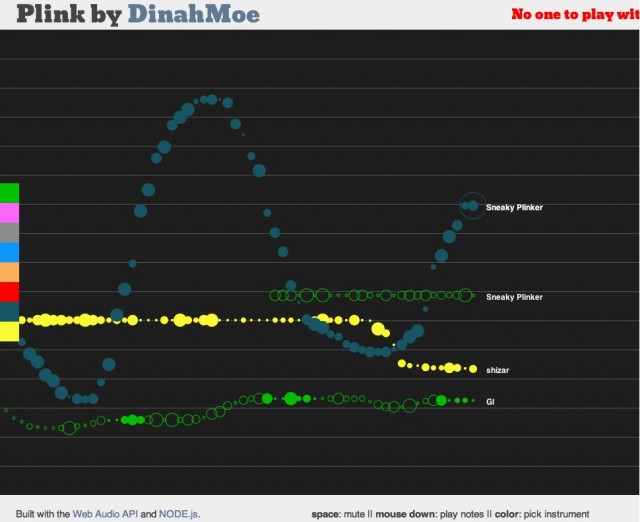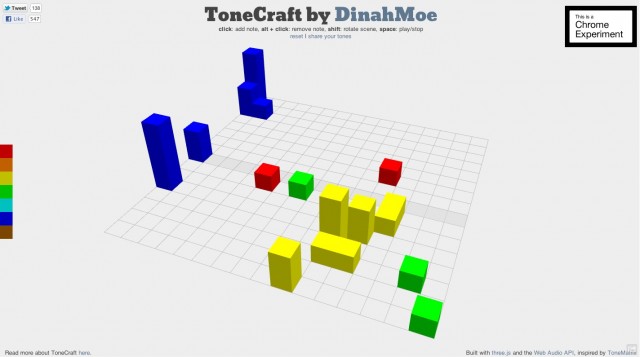It starts as just another toy to play around with in a few minutes of distraction in your Web browser – as if the Web were short on distraction. But then, something amazing can happen. Like a musical Turing Test, you start to get a feeling for what’s happening on the other side. Someone’s stream of colored dots starts to jam with your stream of colored dots. You get a little rhythm, a little interplay going. And instead of being a barrier, the fact that you’re looking at simple animations and made-up names and playing a pretty little tune with complete strangers starts to feel oddly special. The absence of normal interpersonal cues makes you focus on communicating with someone, completely anonymously, using music alone.
Dinah Moe’s “Plink” is the latest glimpse of what Web browser music might be, and why it might be different than (and a compliment to) other music creation technology. You can now create private rooms to blow off steam with a faraway friend, or find new players online. It’s all powered with the Web Audio API, the browser-native, JavaScript-based tools championed by Mozilla. That means you’ll need a recent Chrome or Firefox (Chrome only at the moment; this is a Chrome Experiment), and mobile browsers won’t be able to keep up. But still, give it a try – I think you may be pleasantly surprised. (Actually, do it right now, as you’ll probably be doing it with other CDM readers. I expect greater things!)
http://labs.dinahmoe.com/plink/
Thanks to Robin Hunicke, who worked with multiplayer design and play at That Game Company’s Journey on PS3 and now on the browser MMO Glitch. I think her friends were more musical than most, because the place came alive after she linked from Facebook.
The browser is becoming a laboratory, a place to quickly try out ideas for music interaction, and for the code and structure that describe music in a language all their own. As in Plink, it can also benefit from being defined by the network and collaboration.
Dinah Moe’s experiments go in other directions, as well. In Tonecraft, inspired by the 3D construction metaphor of Minecraft, three-dimensional blocks become an alternative sequencer.
http://labs.dinahmoe.com/ToneCraft/
There are many reasons not to use Web tools. The Web Audio API still isn’t universal, and native options (like Google’s Native Client) have their own compatibility issues, stability concerns, and – because of security – they don’t do all the things a desktop application will. Desktop music tools are still more numerous, more powerful, and easier to use, so if you’re a reader out there finishing a thesis project, you might look elsewhere. (Actually, you’re probably in trouble, anyway, by any nation’s academic calendar, given it’s the First of May, but I digress.)
But think instead of this as another canvas, and the essential building blocks of interface design, code, and networking as shared across browsers and desktop apps. Somehow, in the light of the Internet, its new connectedness, and its new, more lightweight, more portable code and design options, software is changing. That transformation could happen everywhere.
If you need something to help you meditate on that and wait for a revelation to occur to you, I highly recommend watching a soothing stream of dots and some pleasing music as you jam with your mouse.
Of course, in the end, like a digital mirror, it might inspire you to go out to the park with a couple of glockenspiels and jam the old-fashioned way. But maybe that’s another reason to make software.
(Here’s a video, in case you’re not near a browser that supports the app!)
More, plus reflections on adaptive music:
http://labs.dinahmoe.com/

